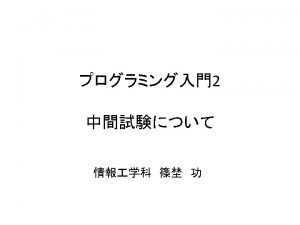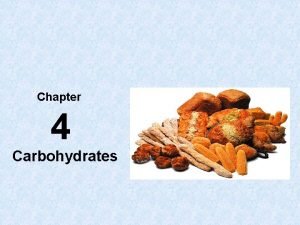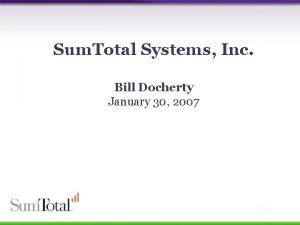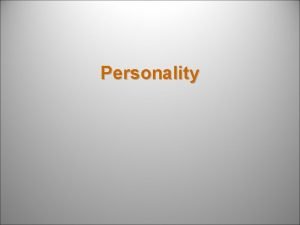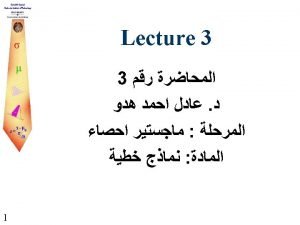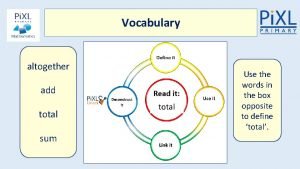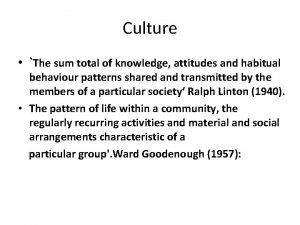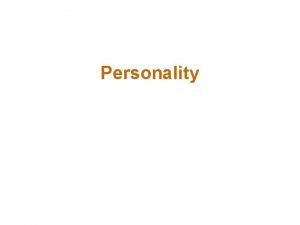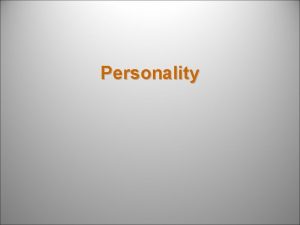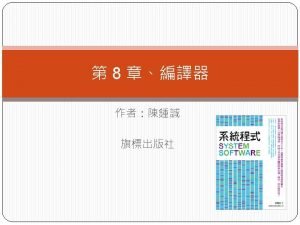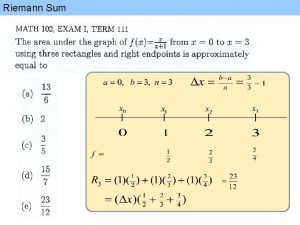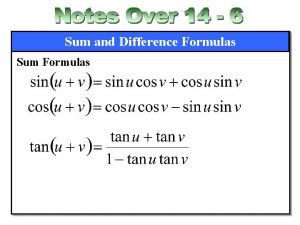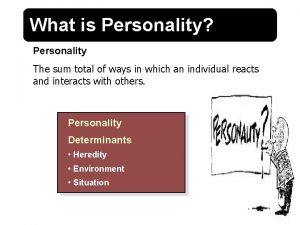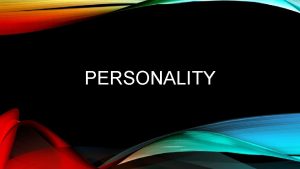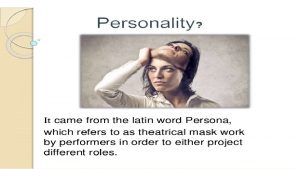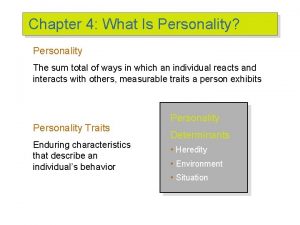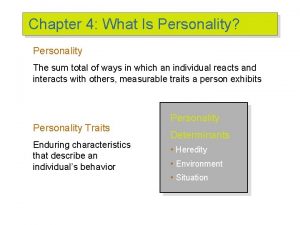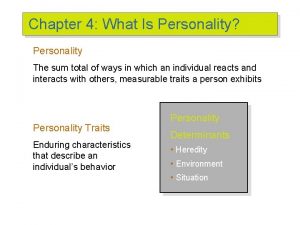Personality What is Personality Personality The sum total



















- Slides: 19

Personality

What is Personality? Personality The sum total of ways in which an individual reacts and interacts with others; measurable traits a person exhibits. Personality Traits Enduring characteristics that describe an individual’s behavior. Personality Determinants • Heredity • Environment • Situation

Personality determinants Ø Heredity Ø Environment Ø Situation

Theories on personality Trait theory MBTI The BIG five model Type A and type B

The Myers-Briggs Type Indicator (MBTI) A personality test that taps four characteristics and classifies people into 1 of 16 personality types. Personality Types • Extroverted vs. Introverted (E or I) • Sensing vs. Intuitive (S or N) • Thinking vs. Feeling (T or F) • Judging vs. Perceiving (P or J) Score is a combination of all four (e. g. , ENTJ)

Meyers-Briggs, Continued A Meyers-Briggs score – Can be a valuable too for self-awareness and career guidance BUT – Should not be used as a selection tool because it has not been related to job performance!!!

The Big Five Model of Personality Dimensions Extroversion Sociable, gregarious, and assertive Agreeableness Good-natured, cooperative, and trusting. Conscientiousness Responsible, dependable, persistent, and organized. Emotional Stability Calm, self-confident, secure under stress (positive), versus nervous, depressed, and insecure under stress (negative). Openness to Experience Curious, imaginative, artistic, and sensitive

Personality Types Type A’s 1. are always moving, walking, and eating rapidly; 2. feel impatient with the rate at which most events take place; 3. strive to think or do two or more things at once; 4. cannot cope with leisure time; 5. are obsessed with numbers, measuring their success in terms of how many or how much of everything they acquire. Type B’s 1. never suffer from a sense of time urgency with its accompanying impatience; 2. feel no need to display or discuss either their achievements or accomplishments; 3. play for fun and relaxation, rather than to exhibit their superiority at any cost; 4. can relax without guilt.

Measuring Personality is Measured By Ø Self-report surveys Ø Observer-rating surveys Ø Projective measures – Rorschach Inkblot Test – Thematic Apperception Test

Major Personality Attributes Influencing OB Ø Core Self-evaluation – Self-esteem – Locus of Control Ø Machiavellianism Ø Narcissism Ø Self-monitoring Ø Risk taking Ø Type A vs. Type B personality Ø Proactive Personality

Core Self-Evaluation: Two Main Components • Self Esteem Individuals’ degree of liking or disliking themselves. • Locus of Control The degree to which people believe they are masters of their own fate. • Internals (Internal locus of control) Individuals who believe that they control what happens to them. • Externals (External locus of control) Individuals who believe that what happens to them is controlled by outside forces such as luck or chance.

Machiavellianism (Mach) Degree to which an individual is pragmatic, maintains emotional distance, and believes that ends can justify means. Conditions Favoring High Machs • Direct interaction with others • Minimal rules and regulations • Emotions distract for others

Narcissism A Narcissistic Person • Has grandiose sense of self-importance • Requires excessive admiration • Has a sense of entitlement • Is arrogant • Tends to be rated as less effective

Self-Monitoring A personality trait that measures an individual’s ability to adjust his or her behavior to external, situational factors. High Self-Monitors • Receive better performance ratings • Likely to emerge as leaders • Show less commitment to their organizations

Risk-Taking Ø High Risk-taking Managers – Make quicker decisions – Use less information to make decisions – Operate in smaller and more entrepreneurial organizations Ø Low Risk-taking Managers – Are slower to make decisions – Require more information before making decisions – Exist in larger organizations with stable environments Ø Risk Propensity – Aligning managers’ risk-taking propensity to job requirements should be beneficial to organizations.

Personality Types Proactive Personality Identifies opportunities, shows initiative, takes action, and perseveres until meaningful change occurs. Creates positive change in the environment, regardless or even in spite of constraints or obstacles.

Achieving Person-Job Fit Personality-Job Fit Theory (Holland) Identifies six personality types and proposes that the fit between personality type and occupational environment determines satisfaction and turnover. Personality Types • Realistic • Investigative • Social • Conventional • Enterprising • Artistic

Holland’s Typology of Personality and Congruent Occupations E X H I B I T 4– 8

Relationships among Occupational Personality Types Source: Reprinted by special permission of the publisher, Psychological Assessment Resources, Inc. , from Making Vocational Choices, copyright 1973, 1985, 1992 by Psychological Assessment Resources, Inc. All rights reserved. E X H I B I T 4– 9
 Int sum(int a int n) int sum=0 i
Int sum(int a int n) int sum=0 i Total fiber refers to the sum of
Total fiber refers to the sum of Docherty talent
Docherty talent Observer personality
Observer personality Define sum total
Define sum total Total sum of squares
Total sum of squares Define sum total
Define sum total Culture is sum of
Culture is sum of Total revenue minus total expenses
Total revenue minus total expenses Total revenues minus total costs equals
Total revenues minus total costs equals Total revenues minus total costs equals
Total revenues minus total costs equals Total revenues minus total costs equals
Total revenues minus total costs equals Uafir fórmula
Uafir fórmula Thế nào là sự mỏi cơ
Thế nào là sự mỏi cơ Trời xanh đây là của chúng ta thể thơ
Trời xanh đây là của chúng ta thể thơ Gấu đi như thế nào
Gấu đi như thế nào Thiếu nhi thế giới liên hoan
Thiếu nhi thế giới liên hoan Fecboak
Fecboak Các châu lục và đại dương trên thế giới
Các châu lục và đại dương trên thế giới Một số thể thơ truyền thống
Một số thể thơ truyền thống
